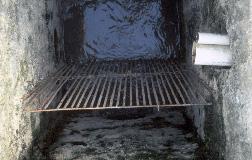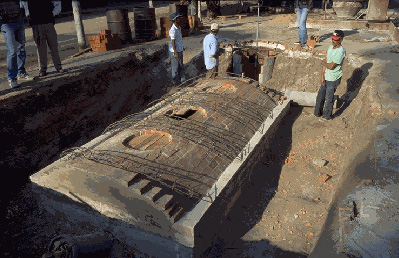This section shows construction and some operational aspects of each component so the builder and operator understand how they function.
Further information on how these modules function is found in the Operations section of this website. The sequence varies greatly depending on site conditions. Therefore, consultation with a wastewater recycling expert is required.
For these consult a wastewater recycling specialist.
Drainage - On wet sites it is often necessary to construct a groundwater and rainwater drainage ditch to divert excess water. Thee are about one meter below ground water level. They are constructed at least three meters away from the location of the outer dyke walls of ponds to avoid seepage from the ponds into the ditch.
Inlet - Is constructed where the collection system enters the site. The inlet box is constructed with a filter grate. This separates solids from water. The box is constructed of concrete and the grate is steel bar or mesh. In cases where infiltration of the collection system is large it is also necessary to construct a shallow sand trap tank immediately prior to or after this grate. It is essential to have this trap accessible by machinery for emptying from time to time, and also to have a space next to the trap to deposit sand for drying and later removal.
 Photo: Overhead view of Inlet box with grate to separate large solids. Silva Jardim, Brazil
Photo: Overhead view of Inlet box with grate to separate large solids. Silva Jardim, Brazil
An overflow canal is constructed from the inlet box to an overflow pond, drainage channel or nearby river to allow by-passing or disposal of excess water if required during operation of the facility.
Pump house or elevator - Avoid a pump if possible due to difficulties and costs associated with pump operation. Pumps are only necessary if the flow is not gravity fed. Size and structure of the pump house varies according to the site. The pump house is constructed to minimize vertical drop from where water has to be pumped.
 Photo: Biogas digester under construction, Cabo Frio, Brazil. Once completed, it is strong enough for a truck to drive over - see page 15 for example of completed digester concealed underground.
Photo: Biogas digester under construction, Cabo Frio, Brazil. Once completed, it is strong enough for a truck to drive over - see page 15 for example of completed digester concealed underground.
Biodigester - Many different models of biodigester are on the market today. Placing the biodigester depends on many factors. For example if a separated collection system is used, it is desirable to construct underground digesters inside the community, to avoid infiltration by sand which may occur over long piping distances. In this case, choose locations in the community as part of the construction plan. In other cases, a large digester may occur at the inlet to the facility.
In this case the digester is constructed after the sand settlement pond and, if used, a livestock pen so waste from animals flows into the biodigester and out to the oxygenation pond after processing.
Oxygenation/algae basin:
- Settles solids, converts organic material into nutrients (i.e. reduces BOD) and neutralizes pathogens with microbiological activity in an aerobic environment.
- Algae in the basin; supply oxygen for bacterial oxidation of organic matter (BOD reduction), promote die-off of microbial pathogens, and provide feed for water fowl and fish when flushed into the next pond.
- The basin is normally 1 meter or less deep to allow full vertical circulation of water to the surface where algae blooms occur. Also for photosynthesis this depth gives a better ratio between pond volume and pond surface than a deeper pond. This helps provide sufficient oxygenation to allow for efficient BOD and pathogen/ fecal coliform reduction.
- The pond is rectangular or oval in shape. It is essential to construct the inlet and outlet so water flows evenly through the whole pond. Otherwise, wastewater flows directly from inlet to outlet, missing the rest of the pond, producing uneven conversion for pathogens and nutrients. Therefore the inlet and outlet should be as far as possible from each other.
- Often settlement pond bottom and lower walls are covered with concrete to prevent seepage into soil at this stage where concentrations of pathogens and nutrients are highest. This also allows emptying of sludge from the bottom of the pond accumulating over months or years depending on the amount of incoming solids. It is very important to pay the concrete properly otherwise the wave action of the pond undermines the concrete and it eventually collapses.
- Two oxygenation basins are normally required for alternate cleaning and good oxygenation.
- Intermediate macrophyte ponds - If fish are contemplated in the system it is necessary to have a macrophyte pond between the algae basin and fish ponds to moderate suspended solids and algae entering into the fish pond.
